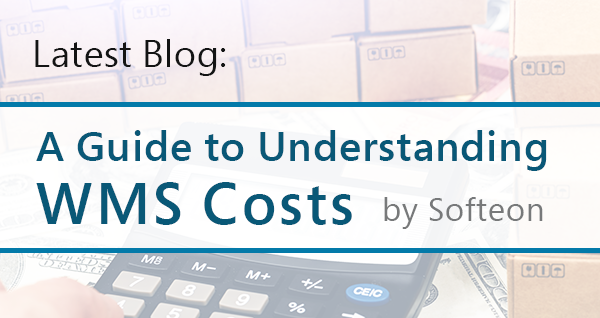Cost of Warehouse Management System Software
Original article: Cost of Warehouse Management System Software
There are many drivers for companies looking for new warehouse management system, WMS software or even a new 3pl warehouse management system. They include:
- You Have a New Facility: Each new distribution center opened offers opportunities to rethink current warehouse software systems
- You are Experiencing Rapid Growth: Changes in demand on your resources can make it difficult to maintain customer service levels
- You are Making Significant Logistics Strategy Changes: When you realize that your current WMS cannot support new processes effectively or at all
- You have or are Consolidating Facilities: This often means combining business units with different requirements that incumbent WMS solutions don’t fully address
- You are striving for Increased DC Automation: Your existing WMS does not support automation, or at least not to the level you need
- Your Distribution Costs are Rising: You are dealing with distribution cost as a percent of revenue rising and becoming too much to bear
- Your Current WMS Technology is Simply Too Old: A “Burning Platform” is increasingly difficult to maintain and very hard to modify for new requirements. With lessening support and updates, possibly a dead platform, etc.
- You are Facing New Omnichannel Fulfillment Requirements: The boom of ecommerce and direct to consumer demands require new strategies and cutting-edge WMS capabilities
- You want to Move to a Cloud-Based System: You may have multiple reasons for moving to the cloud, including subscription-based options and taking advantage of WMS vendor managed services to dramatically reduce internal support requirements
Wide Range of Options and Costs
As with most markets, there is a wide range of capabilities and price points. Points to consider:
- The market is loosely organized around Tier 1, 2 and 3 WMS vendors, with Tier 1 being at the highest price point – but keep in mind that these vendors are well-established and offer the most comprehensive functionality, advanced capabilities, and a broader suite of solutions.
- Don’t just consider the short-term – think about matching current requirements, but more importantly your future requirements. You might only need the services of a Tier 2 vendor today, but will you require Tier 1 capabilities in the future? It may be a better investment decision to act now rather than having to go through another overhaul later, as cost may be higher, implementations will take more time and training could cause delays.
- Average costs for a new solution can range anywhere from $100,000 for a Tier 3 WMS to over $1 million – though most Tier 1 deployments are well below that million-dollar level.
Basic WMS Cost Categories
It is useful to think of costs in terms of on-time/upfront costs and recurring costs. But the model for those cost categories has been dramatically changed by the emergence of WMS delivered in the Cloud, with the software and other cost elements moving from a fixed to a recurring cost and creating a shift in how some deployment costs are incurred.
Cloud Changes the WMS Cost Dynamics
The rapid growth of Cloud delivery generally – and specifically for WMS – has changed the cost dynamics.
With Cloud WMS deployments, the pricing model generally changes for the WMS software from an upfront charge for the software user license to a monthly or quarterly subscription fee to use the software over time.
While traditional software license models are still available from some WMS vendors, the overwhelming trend is for Cloud delivery and subscription-based pricing, so we will focus on that here.
In the Cloud model, upfront costs primarily consist of:
- WMS implementation (requirements definition, system configuration, system and user acceptance testing, integration to existing corporate and/or material handling systems, go-live support, etc.)
- Training
Note that with a Cloud deployment, there are no upfront costs for the WMS software, or for setting-up a technical environment to run the WMS (no in-house computer hardware, databases, app servers, etc.)
With a Cloud deployment, recurring costs primarily include:
- WMS subscription fees, generally payable on a monthly or quarterly basis
- Web hosting fees: Includes setting-up a Cloud environment, provisionally required hardware and software, on-going system maintenance and system tuning, and other needed support; most companies opt for both a production and test environment.
Some WMS vendors combine the WMS subscription fee and other fees into a single monthly cost. More importantly, the web hosting fee is sure to be offset by the near elimination of internal WMS IT support costs.
In a traditional license model, the upfront license fee also comes with an annual maintenance fee – equal to 22-24% of the software license costs. Some WMS vendors continue to charge an annual maintenance fee even for Cloud deployments.
Prospective WMS users should also factor-in potential upgrades over a certain period, say five years, which for some vendors can run in the hundreds of thousands of dollars.
With Softeon, software maintenance and support are included in the web hosting fee. The hosting fee also includes free upgrades, which significantly reduces your TCO (total Cost of Ownership).
There are a few other WMS cost considerations that should be considered:
Other upfront costs can include various types of hardware, including wireless RF terminals, Voice terminals, and barcode label printers. Often, a company already has some existing hardware that can be re-purposed with the new WMS.
If new hardware is required, it can often be sourced from the WMS vendors. But as these are largely commodity devices, a smart strategy can be to source this hardware separately, with the advice and recommendations from the WMS vendor.
Some WMS software vendors, such as Softeon, can leverage inexpensive smart phones for wireless data terminals, and offer native Voice capabilities without the need for dedicated (and often expensive) Voice terminals.
Finally, even with leading WMS solutions, companies must often license supporting software separately, such as parcel shipping management, bar code label design and print management, reporting tools and more.
Other vendors include some or even all of these as part of their core WMS capabilities. Companies evaluating cost of warehouse management systems across vendors should clarify the potential add-on costs in detail. For example, a WMS vendor without its own label printing tools is unlikely to bring that topic to the table on their own, so make sure you know what questions to ask.
WMS Software Cost Drivers
In the end, there are two primary drivers of Warehouse Management System Software costs:
- Number of Users: How many warehouse workers, and potentially office staff, will be using the WMS? At the Tier 1 and Tier 2 WMS levels, the number of “named” (individual) users is the key factor in determining subscription costs. The formula is simply the number of users multiplied by the subscription fee for each per month.
There can be some deviations from this basic model. Those include:
- Tiered Pricing: For example, a subscription fee for the first 100 users, and then a lower fee for users 101-200, etc.
- The subscription for “view only” office workers can be discounted
- The user count for different surges of temporary workers can generally be raised for the surge period only – not the entire year.
- Operational Complexity: What is the scope and scale of the processes and systems the WMS must support? This will directly drive the effort and cost for WMS deployment from the WMS vendor.
As a simple example, a basic “pallet-in, pallet-out” distribution center will be a lot easier for the WMS vendor to configure and deploy than one that picks and ships multiple units of measures and uses automated materials handling systems. So, it is reasonable that the implementation costs for the first scenario would be much lower.
A final consideration is if the WMS is being deployed at a single facility, or as part of a multiple-DC rollout. In the latter scenario, if the facilities use similar processes the deployment costs are often significantly lower for subsequent sites. A company may opt for additional facilities later as they become largely self-sufficient in rolling-out DCs on their own.
WMS Cost Ranges
Given all the variables, it is very difficult to provide exact ranges for WMS software costs. That said, cost ranges for a Tier 1 WMS provided for a first facility might be:
Monthly Subscription Fee: $130 to $180 per user/month (driven by the user count – more users equates to a lower price per user)
*Web hosting costs would be an add-on fee
Implementation Costs: $200,000 to $750,000 (driven by operational complexity)
The key is to perform a full total cost of ownership analysis over a five or seven year horizon to compare full lifecycle costs across all potential vendors. But that analysis must be married with expected benefits to fully understand the value each WMS vendor will bring.
Original article: Cost of Warehouse Management System Software

